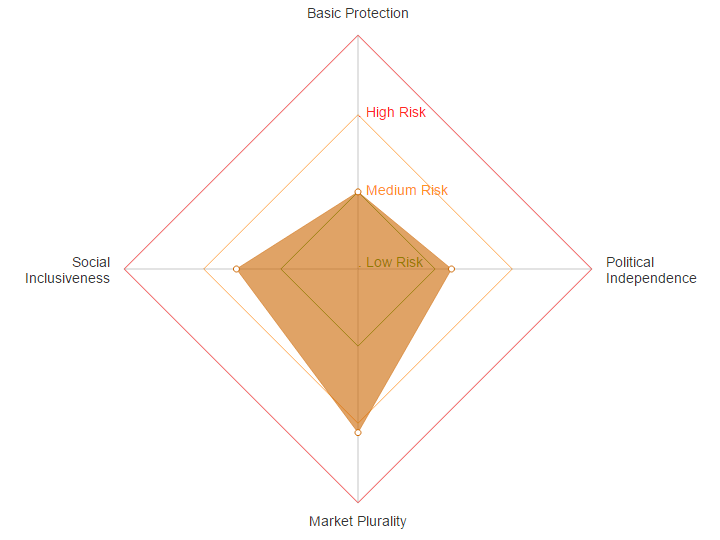Authors:
Beata Klimkiewicz (Jagiellonian University, Kraków)
October 2015
1.Introduction
The condition and evolution of media pluralism in Poland results from a number of exogenous and endogenous factors. Most importantly, the national media environment is shaped by population size, demographic structure and economic conditions. Poland’s population of 38.478 million (GUS 2015) creates a relatively big market for variety of sectors composing the national media. The ethnic and linguistic structure of the population is relatively homogenous, with 97% of citizens identifying themselves as having a Polish nationality. The state officially recognises 9 national minorities and 4 ethnic groups in the Act on national and ethnic minorities and on the regional languages 2005, and a language (Kashubian) officially enjoys the status of a minority and regional language. According to the last 2011 census (GUS 2011), the largest minority group are Silesians (1.1%), who are not officially recognised as a national minority. Other declared minorities account for below 1%. In these circumstances, the overwhelming amounts of media content and services are produced in Polish, largely for the Polish audience. According to the data of the OECD, Poland’s GDP per capita amounted to 22.400 EUR, which places the country below the EU average, but, on the other hand, it represents one of the fastest growing in the last 20 years (OECD 2015). The presence of foreign capital and ownership (both EU and non-EU) in the media sector is quite dominant. According to the Eurobarometer Standard Survey 82 (2014), 83% of the population watch TV every day, 52% listen to the radio, 12% read the newspapers and 54% use the Internet.[1]
The general condition of media pluralism in Poland is satisfactory, although there are areas that need further improvement. Overall, the assessment of the four domains detected a low risk for the ‘Basic Protection’ domain (33%), high risk for the ‘Market Plurality’ domain (70%), medium risk for the ‘Political Independence’; (40%) and for the ‘Social Inclusiveness’; (52%) domains. The greatest risks to media pluralism in Poland include the ‘Concentration of cross-media ownership’ (88%), ‘Media literacy’ (83%) and the ‘Concentration of media ownership’ (74%). Other areas with relatively significant risk for media pluralism include ‘State advertising’ (58%), the ‘Universal coverage of the PSM and the Internet’ (56%), the ‘Centralisation of the media system’ (52%), and the ‘Transparency of media ownership’ (50%).
The assessment completed for this report was conducted between April and October 2015, thus not taking into account new media law developments that sparked the criticism of various international and national organisations.[2] On 30 December 2015, the Polish Sejm enacted the so called ‘Small Media Act’ (Mała Ustawa Medialna) amending the current 1992 Broadcasting Act.[3] The 2015 Act entered into force after signature by the President and the publication of the Act on 7 January 2016. The present report does not cover an assessment of this new law.
2. Results from the data collection: assessment of the risks to media pluralism
Figure 1 Media Pluralism Monitor 2015 – Poland, results by Risk Domain
2.1 Basic Protection (33% risk – low risk)
The Basic Protection indicators represent the regulatory backbone of the media sector in every contemporary democracy and they measure a number of potential areas of risk, including the existence and effectiveness of implementation of regulatory safeguards for freedom of expression and the right to information; the status of journalists in each country, including their protection and ability to work; as well as the independence and effectiveness of national regulatory bodies, namely media authorities, competition authorities and communications authorities.
| Indicator | Risk |
| Protection of freedom of expression | 40% risk (medium) |
| Protection of right to information | 31% risk (low) |
| Journalistic profession, standards and protection | 42% risk (medium) |
| Independence of national authority(ies) | 20% risk (low) |
The indicator ‘Protection of freedom of expression‘ scores medium risk (40%). Freedom of expression is generally respected in Poland, and is protected under the Polish Constitution 1997 in the Article 54 and Article 14 (freedom of the press and the media). In addition, the Press Law 1984 recognises the freedom of expression (Article 1). The Broadcasting Act 1992 stipulates protection of freedom of expression as the task of the National Broadcasting Council (Article 6 (1)). Poland has ratified the relevant international documents in this regard, including ICCPR (in 1977) and ECHR (in 1993). In the evaluation of international organizations (Freedom House 2015; Reporters Without Borders 2015), Poland has been ranked among the countries with a free press between 2005 – 2015.
However, it should be added, in this respect, that the State has not decriminalised defamation. A relatively formalistic treatment of some defamation cases by the domestic courts leads repeatedly to applications being submitted to the ECHR, judging time and again a violation of Article 10 of the Convention (e.g,. Applications nos. 19127/06; 48723/07; 34447/05). The overall score for this indicator amounts to 40% thus detecting a medium risk to media pluralism.
The indicator ‘Protection of right to information‘ scores low risk (31%). The right to information is explicitly recognised in the Polish Constitution (Article 61), and, in addition, it is protected by the Law on Access to Public Information 2001. In practice, the effective implementation is affected by the limits of a relatively narrow definition of public information and delays in timely responses to information requests. The overall score for this indicator (31%) represents a low risk.
The indicator ‘Journalistic profession, standards and protect‘ scores a medium risk (42%). An institutional landscape of journalistic associations and unions in Poland is very fragmented. This fragmentation, often deepened by ideological cleavages, hinders attempts to represent the journalistic environment as a whole in policy and employment negotiations. According to the indices by Reporters Without Borders (2015) and Freedom House (2015), no journalists and no net-citizens were killed, attacked or imprisoned in Poland in 2014 and 2013. Yet, very rarely, some attacks or threats to the physical or digital safety of journalists happen. The overall score for this indicator (42%) represents a medium risk.
The indicators on the ‘Independence of the national authority‘[4] score a low risk (20%). The independence of the three relevant national authorities – the National Broadcasting Council (Krajowa Rada Radiofonii i Telewizji – KRRiT), the Office of Competition and Consumer Protection (Urząd Ochrony Konkurencji i Konsumentów –UOKiK), and the Office of Electronic Communication (Urząd Komunikacji Elektronicznej – UKE) is not recognised as being a value to be explicitly protected by constitutional or other relevant (media, competition, telecommunication) laws. Comparing the three authorities in the light of their particular conditions of independence and effectiveness (sufficient budget, clearly defined duties, tasks and responsibilities; sanctioning powers), the appointment procedures seem to be the weakest element – and one that will eventually need improvement.
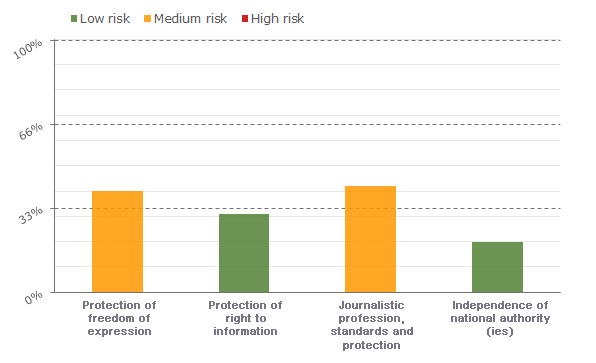
2.2 Market Plurality (70% risk – high risk)
The Market Plurality indicators examine the existence and effectiveness of implementation of transparency and disclosure provisions with regard to media ownership. In addition, they assess regulatory safeguards against high concentration of media ownership and control in the different media, within a media market as well as cross-ownership concentration within the media sector.
| Indicator | Risk |
| Transparency of media ownership | 50% risk (medium) |
| Concentration of media ownership | 74% risk (high) |
| Concentration of cross-media ownership | 88% risk (high) |
The indicator on ‘Transparency of media ownership‘ scores medium risk (50%). In general, there are several obligations in the company and broadcasting laws that require the disclosure of certain data about media ownership (see Code of Commercial Partnership and Companies 2000; Act on National Court Register 1997; Broadcasting Act 1992). At the same time, the free-of charge service of the National Court Register offers only limited information. Most of the data are collected by the public agencies (such as KRRiT and UOKiK). None of these, however, offers a full register, easily disclosing up-to-date information to the general public. The overall score for this indicator (50%) represents a medium risk.
The indicator on ‘Concentration of media ownership‘ scores high risk (74%). Both competition and broadcasting laws tackle some forms of horizontal media concentration only. The Act on Competition and Consumer Protection 2007 does not specifically recognise the media sector. The basis for preventing high horizontal concentration on the press market, as well as in the internet content providers’ sector, is the general competition law. As regards the broadcasting market, in addition to competition law, the relevant body – KRRiT – may use the provisions of the Broadcasting Act 1992 to award, refuse or revoke licenses in order to prevent the dominant position of a broadcaster in a given area. The concentration in revenue and audience markets is rather high in Poland. In 2013, altogether, the Top 4 audiovisual owners achieved 95% shares in the revenue market, and the Top 4 radio owners 78% (KRRiT 2015). The share of the four leading press groups in the overall circulation of the press market reached around 70% (Izba Wydawców Prasy 2015; ZKDP 2015). There is no freely available data to establish the market share of the Top4 internet content providers in Poland. The overall score for this indicator (74%) suggests a high risk.
The indicator on ‘Concentration of cross-media ownership‘ scores a high risk (88%). Current media and competition laws do not contain specific rules that can prevent a high degree of cross-ownership between the different media. The overall score for this indicator proves to be the highest amongst all of the indicators – 88%, thus pointing to a high risk to media pluralism.
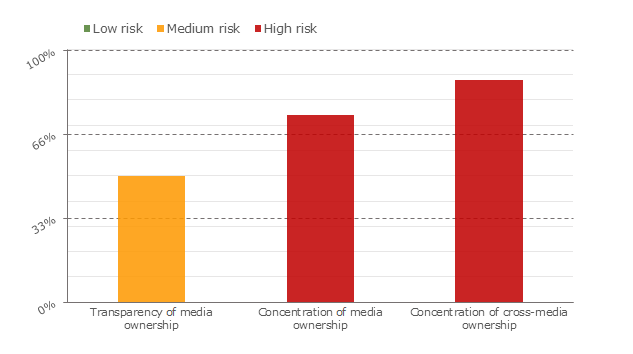
2.3 Political Independence (40% risk – medium risk)
The Political Independence indicators assess the existence and effectiveness of implementation of regulatory safeguards against biased representation of political viewpoints in the media, and also the extent of politicisation over media outlets, media distribution networks and news agencies. Moreover, it examines influence of the state on the functioning of the media market, with a focus on state advertisement and public service media.
| Indicator | Risk |
| Political bias in the media | 43% risk (medium) |
| Politicisation of control over media outlets | 44% risk (medium) |
| Politicisation of control over media distribution networks | Negligible |
| State advertising | 58% risk (medium) |
| Independence of PSM governance and funding | 33% risk (low) |
| Independence of news agencies | 62% risk (medium) |
The indicator on ‘Political bias in the media‘ scores a medium risk (43%). The Broadcasting Act 1992 stipulates that information provided by PSM should be ‘pluralistic, impartial, well balanced, independent and innovative’ (Article 21.1.). As regards political representation, in particular, PSM has the duty to represent the positions of political parties, trade unions and employers’ organizations (Article 23), entities participating in elections (Article 24.1), and to inform on the activities of public benefit organisations (Article 23a). In practice, the available studies and experts’ accounts show both the existence of the diversity of political parties and movements in media content (mainly during election periods), as well as a lack of a sufficient political balance (INDICATOR 2012; Dobek-Ostrowska, B & Głowacki 2008). The overall score for this indicator (43%) demonstrates a medium risk.
The indicator on the ‘Politicisation of control over media outlets‘ scores a medium risk (44%). Most media groups in Poland have no direct political affiliation with political groups and parties. Yet political directions are often reflected in editorial policies and journalistic content (Freedom House 2015; Jakubowicz 2007; Mielczarek 2007). The overall score for this indicator amounts to 44%, thus suggesting a medium risk.
The indicator on the ‘Politicisation of control over media distribution networks‘ scores a negligible risk. The leading distribution networks for print, radio and TV are privately owned and have no particular political affiliation. Political control does not pose any serious threats in this regard, although, in certain markets (e.g., terrestrial digital TV) there is a problem with dominant players. The overall score for this indicator displays a negligible risk.
The indicator on ‘State advertising‘ scores a medium risk (58%). In media laws (1984 Press Law, 1992 Broadcasting Act), there are no rules on the distribution of state advertising. In addition, relevant data seem to be very limited. The available reports (2013, 2014) monitoring the government advertising notice the non-proportional distribution of expenditures. The overall score for this indicator (58%) suggests a medium risk.
The indicator on the ‘Independence of PSM governance and funding‘ scores a low risk (33%). The Broadcasting Act 1992 provides transparent and clearly described appointment procedures for the management and supervisory boards of PSM (Articles 27 and 28). Yet, these do not guarantee the independence of the PSM boards from the governing political groups. The political culture in Poland has repeatedly proven that there has been a big appetite for the political control of both KRRiT and PSM’s Supervisory, as well as the Management Boards (See e.g., Ociepka 2003). Although the overall score for this indicator denotes a low risk (33%) it represents a perimeter value that is close to crossing the line to becoming a medium risk.
The indicator on the ‘Independence of news agencies‘ scores a medium risk (62%). The dominant position amongst the leading news agencies in Poland is occupied by PAP (Polish Press Agency – Polska Agencja Prasowa). Other agencies tend to specialise in some specific parts of the news/information market. Formerly controlled by the state, PAP has become independent from the government in its operations, although it is still owned by the State Treasury (Act on PAD 1997). The overall score for this indicator (63%) demonstrates a medium risk.
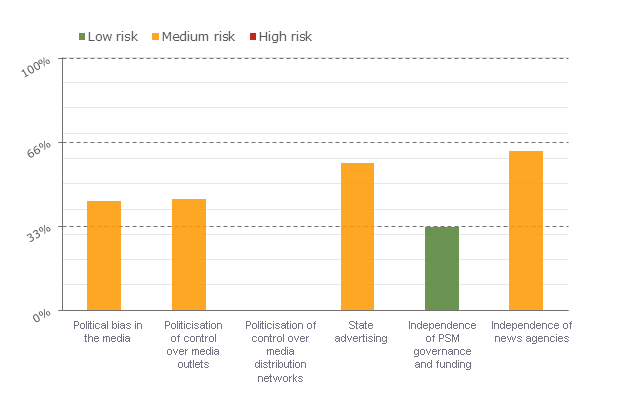
2.4 Social Inclusiveness (52% risk – medium risk)
The Social Inclusiveness indicators are concerned with access to and availability of media for different, and particularly vulnerable, groups of population. They assess regulatory and policy safeguards for access to media by various cultural and social groups, by local communities and by people with disabilities. Moreover, they assess the centralisation of the media system, and the quality of the country’s media literacy policy, as well as the digital media skills of the population.
| Indicator | Risk |
| Access to media for different social and cultural groups, and local communities | 47% risk (medium) |
| Availability of media platforms for community media | 47% risk (medium) |
| Access to media for the physically challenged people | 25% risk (low) |
| Centralisation of the media system | 52% risk (medium) |
| Universal coverage of the PSM and the Internet | 56% risk (medium) |
| Media literacy | 83% risk (high) |
The indicator on ‘Access to media for different social and cultural groups‘ and local communities scores a medium risk (47%). An access to airtime on PSM channels for different social and cultural groups is recognised, at a very general level, in the Broadcasting Act 1992 (Articles 21.1a, 21.2, 23a1). Access to airtime on PSM by minorities is guaranteed by the Broadcasting Act 1992 (Article 21.1a), however, this refers only to minorities that are officially recognised under the 2005 Act on National and Ethnic Minorities and on the regional languages. As regards the operation and performance of Polish Radio (Polskie Radio), the diversity of social and cultural, and, in particular, regional groups, is relatively well-reflected in the content offer and service of its 17 regional branches. In the case of Polish Television, the coverage is less representative, in particular in regard to ethnic and national minorities and cultural groups. The overall score for this indicator (47%) demonstrates a medium risk.
The indicator on the ‘Availability of media platforms for community media‘ scores a medium risk (47%). The Broadcasting Act 1992 does not contain specific provisions granting legal recognition to community media as a distinct group alongside commercial and public media. However, the law distinguishes the category of ‘social broadcaster’. The Broadcasting Act 1992 exempts social broadcasters from fees that are payable for the awarding or altering of the license. The overall score for this indicator amounts to 47%, showing a medium risk.
The indicator on ‘Access to the media for physically challenged people‘ scores a low risk (25%). The policy relating to access to media content by physically challenged people has improved in recent years. The amended Broadcasting Act 1992 requires broadcasters to reserve 10% of the quarterly transmission time for programmes with appropriate aids. The National Broadcasting Council regularly monitors the fulfillment of these obligations by broadcasters. The overall score for this indicator (25%) denotes a low risk.
The indicator on the ‘Centralisation of the media system‘ scores a medium risk (52%). In general, there are distinctions among the local press, radio and TV, and the policy support that relates to these sectors. While, in the case of broadcasting, the PSM offer a visible contribution to the system of local/regional media in Poland, the press seems to be relatively fragile. The decentralisation index for 2014 demonstrates a weak audience share for local/regional media in the overall audience for each of the sectors: 34% for daily newspapers (ZKPD 2015), 35% for radio stations (KRRiT 2015) and 1.1% for TV channels (KRRiT 2015). The overall score for this indicator (52%) points to a medium risk.
The indicator on ‘Universal coverage of PSM and the Internet‘ scores a medium risk (56%). The Broadcasting Act 1992does not explicitly refer to ‘universal coverage’, but the law firmly states that PSM should target ‘the entire society’ and ‘its individual groups’ (Article 21.1.). The quantitative indicators demonstrating the universal coverage of PSM channels vary between high and low risk, while most of the data for internet coverage point to a medium risk. The overall score for this indicator (56%) thus demonstrates a medium risk.
The indicator on ‘Media literacy‘ score a high risk (83%). ‘Media literacy’ or ‘media education’ is recognised as being one of the leading tasks of both KRRiT and PSM (Broadcasting Act 1992, Articles 6.2; 21.1a). At the same time, the data demonstrating the percentage of weekly Internet users and the percentage of the population that has at least basic digital skills indicate a high risk. The overall score for this indicator (83%) denotes a high risk.
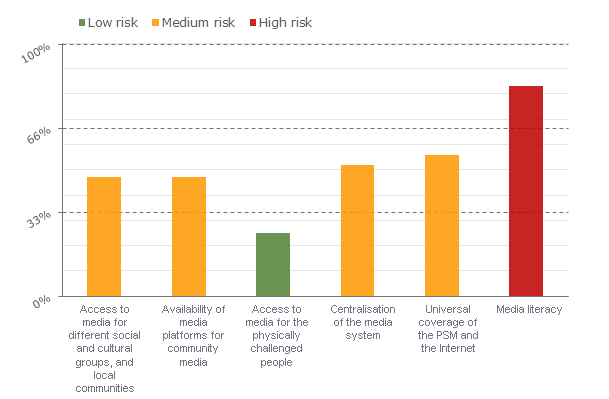
3. Conclusions
Based on the findings of the MPM2015, the following issues have been identified by the country team as more pressing or deserving particular attention by policy-makers in order to promote media pluralism and media freedom in the country. .
The assessment of media pluralism in Poland detected some policy areas that could benefit from further improvements.
In the ‘Basic Protection’ domain, two issues should be mentioned, in particular. There is a need for the decriminalisation of defamation and to ensure that public figures do not hold a higher level of protection under the libel law than ordinary citizens do. Secondly, there is a need to provide a more pluralistic representation, in terms of appointment procedures, to the regulatory bodies, particularly the National Broadcasting Council (KRRiT). The composition of the national media authority should not reflect only the political structure of the Sejm, Senate, and President, but also of the social and cultural milieux, including NGOs, educational institutions, journalistic associations, and others.
In the ‘Market Plurality’ domain, there is a need to address cross-media ownership, at least in media regulation, and to establish competition policy regimes that are more sensitive to specific features of the relevant media markets. Secondly, the issue of media transparency requires a more focused policy response. There is a need to offer full public access to the media register that lists media companies which are operating in Poland. This list should include:
- An indication of the ultimate owner (not only the name of a subsidiary company)
- Information about the location of the company’s seat (often companies register in tax havens)
- An indication of whether the company pays taxes in Poland
- A full catalogue of the owned media services and outlets, including social media, online portals, outdoor advertising, etc.
- Total revenues
- Advertising revenues, with detailed information on the proportion of revenues collected from state or public advertising
In the ‘Political Independence’ domain, there is a need to specify, in greater detail, the PSM remit, in particular, the tasks regarding the impartial and fair representations of political views. Secondly, a significant improvement is necessary in the area of the disclosure of data on state advertising and its distribution across particular media outlets. Thirdly, PSM need refined appointment procedures, with a greater representation of the civil society in Poland, including NGOs, educational institutions, journalistic associations, and others.
In the ‘Social Inclusiveness’ domain, to effectively safeguard regional/local media by policy measures, there should be a more coherent and holistic approach to the entire media system, and not simply a reliance on the tasks of PSM in this matter, or on the municipal support that is often bound by high political dependency on local politics. This applies also to the third sector of community media. In the first place, it is necessary to recognise community media, both in law and in the policies of the national media authority. Finally, as regards media literacy, there is a lack of regular policy activities in two important areas: media transparency, with an explanatory background on economic and political context of media operations, and regular measurement/analysis concerning media users’ abilities and skills to effectively and safely use offered media services. These should be provided on a regular basis in order to detect trends relating to media literacy.
Annex I. List of consulted national experts
Maria Borkowska – National Broadcasting Council (KRRiT)
Maciej Hoffman – Press Publishers’ Chamber (IWP)
Jędrzej Skrzypczak – Faculty of Political Sciences and Journalism, Adam Mickiewicz University in Pozn
Alicja Jaskiernia – Institute of Journalism, University of Warsaw
References
Dobek-Ostrowska, B & Głowacki, M (eds.) 2008, Comparing Media Systems in Central Europe: Between Commercialization and Politicization, Wydawnictwo Uniwersytetu Wrocławskiego, Wrocław.
Freedom House 2015, Freedom of the Press, viewed 19 September 2015, https://www.freedomhouse.org/report-types/freedom-press.
GUS [Central Statistical Office] 2011, Raport z wyników: Narodowy Spis Powszechny Ludności i Mieszkań 2011 [The Concluding Report: 2011 Census], viewed 15 October 2015, https://stat.gov.pl/cps/rde/xbcr/gus/lud_raport_z_wynikow_NSP2011.pdf.
GUS [Central Statistical Office] 2015, eSize and structure of population and vital statistics in Poland by territorial division in 2014, viewed 15 October 2015, https://stat.gov.pl/obszary-tematyczne/ludnosc/ludnosc/ludnosc-stan-i-struktura-ludnosci-oraz-ruch-naturalny-w-przekroju-terytorialnym-stan-w-dniu-31-xii-2014-r-,6,17.html.
INDICATOR 2012, Pluralizm w polskich mediach elektronicznych [Pluralism in the Polish electronic media], Warszawa: N.d..
Izba Wydawców Prasy [Chamber of Press Publishers] 2015, Lista tytułów [The List of Press Titles], viewed 15 October 2015, https://www.iwp.pl/lista_tytulow.php?menu=2&IWP_wydawnictwaPage=9.
Jakubowicz, K 2007, Rude Awakening: Social and Media Change in Central and Eastern Europe, Hampton Press, Creskill, New Jersey.
KRRiT [National Broadcasting Council ] 2015, Informacja o podstawowych problemach radiofonii i telewizji w 2014 roku [information about basic issues concerning radio and television in 2014], viewed 15 October 2015, https://www.krrit.gov.pl/krrit/sprawozdania/.
Mielczarek, T 2007, Monopol, pluralizm, koncentracja. [Monopoly, pluralism, concentration], Wydawnictwa Akademickie i Profesjonalne, Warsaw and others.
Ociepka, B 2003, Dla kogo telewizja? Model publiczny w postkomunistycznej Europie Środkowej, Wydawnictwo Uniwersytetu Wrocławskiego, Wrocław.
OECD 2015, Level of GDP per capita and productivity, viewed 15 October 2015, https://stats.oecd.org/Index.aspx?DataSetCode=PDB_LV#.
Reporters Without Borders (2015), Press Freedom Index, viewed 19 September 2015, https://en.rsf.org/press-freedom-index-2013,1054.html.
ZKDP [Polish Audit Bureau of Circulation] 2015, Rok 2014 [Data for 2014], viewed 15 October 2015, https://www.teleskop.org.pl/zkdp/index.jsp?p=publicDataNoReg.
Legislation
Act on Competition and Consumer Protection [Ustawa o Ochronie Konkurencji i Konsumentów] 2007, Official Journal 2007, No 50, item 331, as amended, adopted on 16 February 2007, viewed 15 October 2015, https://isap.sejm.gov.pl/DetailsServlet?id=WDU20070500331>.
Act on national and ethnic minorities and on the regional languages [Ustawa o mniejszościach narodowych i etnicznych oraz o języku regionalnym] 2005, Official Journal 2005, No 17, item 141, adopted on 6 January 2005, viewed 15 October 2015, https://isap.sejm.gov.pl/DetailsServlet?id=WDU20050170141.
Act on National Court Register [Ustawa o Krajowym Rejestrze Sądowym] 1997, Official journal 1997, No 121, item 769, Official Journal 1997, No 121 item 769
Act on PAP [Ustawa o Polskiej Agencji Prasowej] 1997, Official Journal 1997, No 107, item 687, as amended, adopted on 31 July 1997, viewed 15 October 2015, https://isap.sejm.gov.pl/KeyWordServlet?viewName=thasP&passName=Polska%20Agencja%20Prasowa.
Broadcasting Act [Ustawa o Radiofonii i Telewizji] 1992, Official Journal 1993, No 7, item 34, as amended, adopted on 29 December 1992, viewed 15 october 2015, https://www.krrit.gov.pl/Data/Files/_public/Portals/0/angielska/Documents/Regulations/broadcasting_act_28022013.pdf.
Code of commercial partnership and companies [Kodeks spółek handlowych] 2000, Official Journal 2000, No 94, item 1037, adopted on 15 September 2000.
Law on Access to Public Information [Ustawa o dostępie do informacji publicznej] 2001, Official Journal 2001, no 112, item 1198, as amended, adopted on 6 September 2001, viewed 15 October 2015, https://isap.sejm.gov.pl/DetailsServlet?id=WDU20011121198.
Press Law [Ustawa Prawo Prasowe] 1984, Official Journal 1984, No 5, item 24, as amended, adopted on 26 January 1984, viewed 15 October 2015, https://isap.sejm.gov.pl/DetailsServlet?id=WDU19840050024.
[1] See: https://ec.europa.eu/public_opinion/archives/eb/eb82/eb82_media_fr.pdf; retrieved 3.11.2015.
[2] See the reactions of: Council of Europe (https://www.coe.int/en/web/media-freedom/all-alerts?p_p_id=sojdashboard_WAR_coesojportlet&p_p_lifecycle=0&p_p_state=normal&p_p_mode=view&p_p_col_id=column3&p_p_col_count=2&_sojdashboard_WAR_coesojportlet_alertPK=13859384&_sojdashboard_WAR_coesojportlet_jspPage=%2Fhtml%2Fdashboard%2Fview_alert.jsp), EU (https://www.rferl.org/content/eu-debate-new-polish-media-law/27465476.html); OSCE (https://www.osce.org/fom/213391); EBU (https://www3.ebu.ch/news/2015/12/ebu-appeals-to-polish-president); KRRiT – National Broadcasting Council (https://www.krrit.gov.pl/en/for-journalists/press-releases/news,2192,krrits-statement-on-the-bill-amending-the-broadcasting-act.html), retrieved 12 January 2016.
[3] See the English translation of the document: https://www.krrit.gov.pl/en/for-broadcasters-and-operators/legal-regulations/; retrieved 12 January 2016.
[4] NB: It needs to be noted that this indicator has been found to be problematic in the 2015 implementation of the Media Pluralism Monitor. The indicator aimed to combine the risks to the independence and effectiveness of media authorities, competition authorities and communication authorities was found to produce unreliable findings. In particular, despite significant problems with regard to the independence and effectiveness of the authorities in many countries, the indicator failed to pick up on such risks and produced and overall low level of risk for all countries. The indicator will be revised for further versions of the MPM (note by CMPF).

